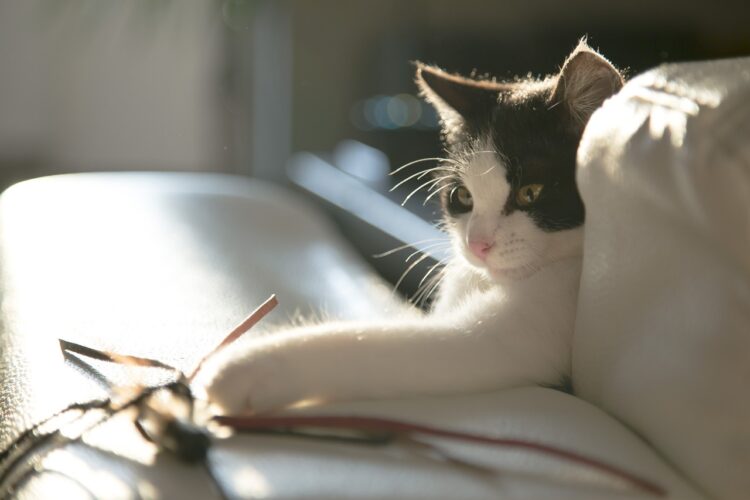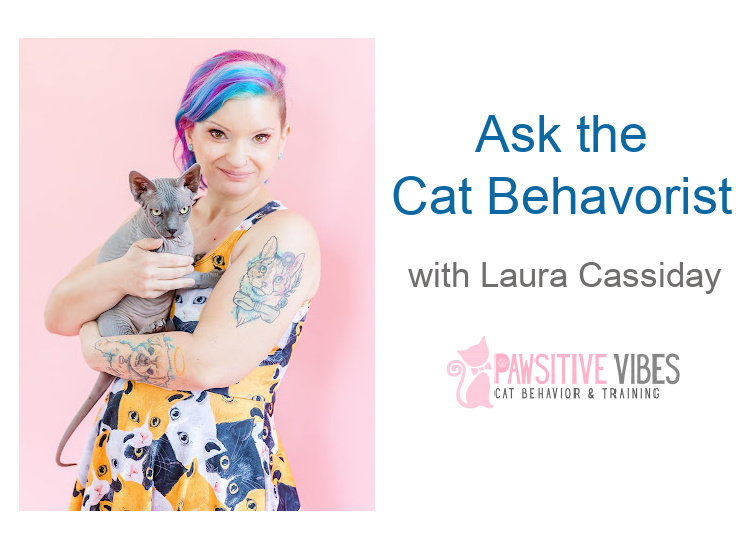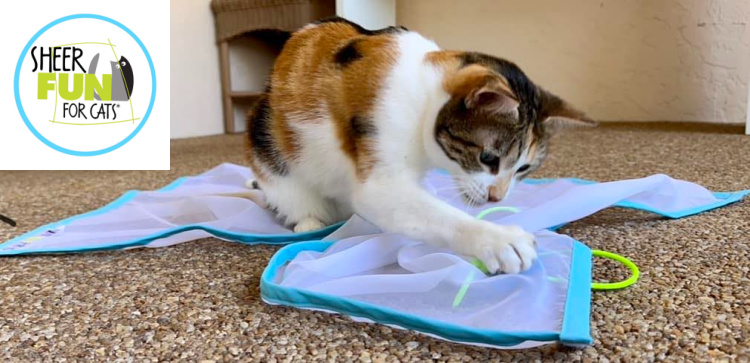
Guest post by Laura Cassiday
Playing with your cat is important. You know this. But do you know why?
When you play fetch, or tug-o-war with a dog, it’s a social bonding experience. You’re playing together. When you’re playing with your cats, however, you’re just a prop. You are providing them with a simulated hunting experience. Domestic cats are some of nature’s deadliest predators. Wild or feral cats can spend up to 80% of their time awake hunting prey, and the average cat would need to eat about ten mice per day in order to get their needed number of calories. That’s a LOT of hunting!
Play should simulate hunting behavior
Indoor-only cats can’t exactly do that. They may get the chance to catch a bug here and there, or chatter as they watch a bird out the window. This can cause frustration and boredom, and in turn, destructive or aggressive behavior. But what’s the solution? You can’t play with your cat for hours a day!
Good news. You don’t have to. Cats are ambush predators. They lie in wait, then make one mad dash for their prey. Their bodies are not designed to move and move and move for long periods of time. In order to simulate real life, your play sessions should only be 10 to 15 minutes at the most. You should start fast, letting the cat run and jump at first if they’d like, then finish slow, dragging the toy slowly around corners and winding down the cat’s energy.
Too much play can cause behavioral problems
What happens if you play more than that? Well, I’ve had many clients where that’s about the time they get scratched or bitten, or when that cat goes and attacks or bothers another cat in the home. They’re over-aroused and are having a tough time calming themselves down. This practice also creates the type of cat that people complain about never being satisfied and wanting to play for hours and hours and hours.
Short sessions where the cat is allowed to calm down at the end are best. What’s even better is scheduling play times at the same time every day. Most cats — even crazy young ones and kittens — can be fully satisfied with two or three 10-minute play sessions a day as long as they have other enrichment opportunities and the play times are consistent at the same time each day (usually morning and evening, with an optional session midday or afternoon).
Schedule play time
Scheduling your play accomplishes lots of things. Cats are crepuscular, so they are most active at dawn and dusk. That’s when they’d be doing the most hunting, so that’s the best time to play. If your cat has destructive or aggressive tendencies, you’re probably realizing right about now that he’s at his worst in the morning and evening, too.
Cats thrive on a predictable routine. Indoor living is boring. Waiting around wondering when you’re going to get your playtime (or worse, resorting to problem behavior in order to get attention) isn’t fun for anyone. Scheduling playtime lets your cat know that every day, he’s going to get his needs met.
Worried about being able to stick to that consistent scheduled playtime each day? Don’t be. Does your cat ever forget when it’s time for dinner? Just commit to sticking to scheduled play for a week, and after that, your cat will never let you forget. Can’t commit to 10 entire minutes at once? Do it in chunks. Wake up, play for a minute. Take a shower, play for three minutes. Brush your teeth, play for two minutes. Before you know it, you’re ready for the day and your cat has been played with. I like to let the cat clearly know when playtime starts and stops by keeping the favorite toy in a cabinet or drawer. When it comes out, it’s time to play. When it’s put away, playtime is over. It also gives the cat a clear way to ask for playtime – by running over to the drawer where the toy is kept.
Troubleshooting Play Problems
“My cat has dozens of toys and he doesn’t play with any of them.”
Toys on the floor are boring. They are dead. They are stationary. Cats are interested in MOVEMENT! Are your toys always left out? Your indoor cat doesn’t get out much. He’s tired of seeing the same stuff every day. Put them away when you’re not using them!
“My cat will play with the same toy for a while, but then loses interest.”
Stop buying endless new toys! Rotate them instead to keep things new and exciting. You can even “marinate” them in a plastic baggie full of catnip while they’re not in use.
“My cat won’t engage in any interactive play with me.”
Schedule those play sessions! You also may have a “specialist” hunter. Maybe they don’t want to hunt a bird, and they’d rather hunt bugs, or mice, or snakes. Is your cat overweight? A senior? Not feeling well? A cat who won’t play is like a cat won’t eat – that’s a reason for concern. Are other cats around? Cats are solitary hunters and may need separate play sessions.
“My cat only wants to play for five minutes.”
Okay, cool. Cats are sprinters. Their bodies aren’t designed to move for long periods of time. He may need a break, and you can try again later.
“My cat won’t stop playing. He could play for hours.”
Not cool. Nobody has time for that! Be careful not to accidentally create a super-cat with unattainable needs. Wind down play sessions, allowing your cat to catch the prey and sloowww down. If your cat is still amped after 15 minutes, try feeding a small meal or switching to cognitive enrichment.
More play tips
- Alternate speed of movement. Are you going too fast? Too slow?
- Move the toy away from your cat. Prey doesn’t run up to the predator!
- Move the toy under or behind something. Let it go jusssstt out of view. Cats won’t be able to resist.
- Appeal to other senses. Try scented toys, toys that make noise, or toys with different textures.
- Recognize that different cats will have different play styles. Play does not have to be running and jumping! It can be stalking, batting, following, watching, etc.
- Be the prey. Your cat is nature’s tiny killing machine. Let him kill his toy.
Play involves YOU. Interactive play is a basic need for your cat, and playing with them on a regular basis should be a requirement of being a cat caregiver.

Have any questions for me about play? Please leave them in the comments below and see them answered next month!
Laura Cassiday is a certified cat behavior consultant (CCBC) and owner of Pawsitive Vibes Cat Behavior and Training. Laura is certified through the International Association of Animal Behavior Consultants. She is also a Fear Free certified animal trainer. Laura recently published her first book, The Complete Guide to Adopting a Cat (affiliate link*.) She works with cat guardians remotely from all over the world, as well as in-person in her local area of Baltimore, Maryland. For more information, visit Pawsitive Vibes Cat Behavior and Training.
Image Pixabay






Hi Laura,
thank you for this informative article on playing with your cat, I always appreciate the advice that you share!
I wanted to know your thoughts about a 3 year old cat that was found as a stray. He has been in two different homes already and tends to get overstimulated easily when there is a lot going on in his environment. He was given up because he was stalking and attacking the humans in his former homes. Currently he is on Fluoxetine to help him relax and we’ve tried to get him on a regular play schedule- which has been a bit of an uphill battle since he seems to tend to want to lie down and chill more often on his meds.
nonetheless we attempt play time and he does have times where we get him to pounce and bunny kick his interactive toys. But there still have been times when he will stop play, focus (direct stare) on the person and pounce (attack) them.
this happens at other times too- once while he was eating- he turned and focused on the person with him then quickly pounced on them.
He seems to return to normal pretty quickly after these events but when he has these moments he can’t be distracted by toys or noises and keeps approaching even if the person stands still.
when he’s relaxed he’s a wonderful affectionate cat but it seems when he’s engaged in some other activity he can be unpredictable as to when he will just suddenly shift his focus to the person with him.
Do you think this is still a form of play aggression – or that maybe we are still not correctly playing with him? I’m at a loss as to how to change or work with his behavior. Can you offer any thoughts?
Thank you so much again for all the great advice you offer!
Karen
Hi! Our cat used to play a lot as a kitten (actively chasing balls, catching things under a blanket, chasing those feather wands etc). She seems to have outgrown that – now we hardly get her to chase anything. She sometimes watches, but often gets distracted by a sound or something and walks away. It‘s really hard to get her to play, and when we manage, it‘s not a lot of chasing but maybe catching a stick from right in front of her. She also has no interest in catnip or anything of the sort to make toys more enticing.. She calls for attention but then doesn‘t really want to play or cuddle. She‘s a bit of an oddball due to growing up alone (rescue from day 1, whole family died), so she‘s not great at grooming and other normal cat behaviour. I‘m worried she‘s bored/we did something wrong raising her.
Laura, it’s always a delight when you are here at Purrs of Wisdom!
I learn so much from you and I’m grateful for the information and advice you have provided for my cats. You have helped me make a better and happier life for them!
Thank you for the excellent article. I usually try to play with my cats for at least 15 minutes daily. I noticed that they get along with each other much better when play is incorporated into their day and that makes me VERY happy!
Miss Lulu just informed me we need more play time.